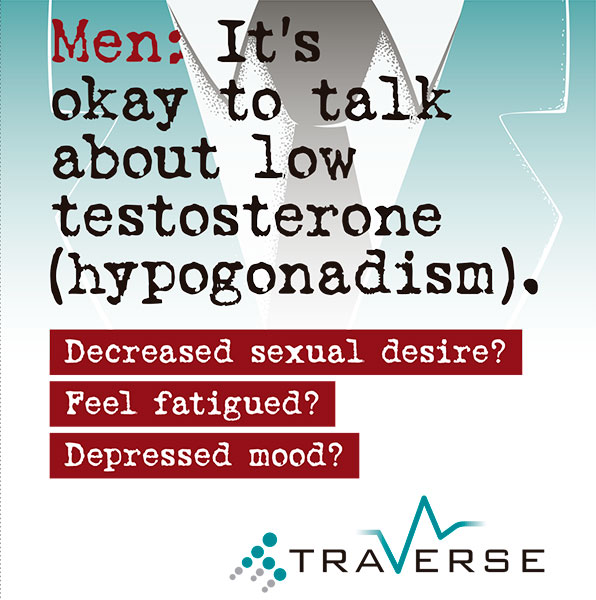What is Hypogonadism?
Hypogonadism is the inability of the gonads, the testes in men and the ovaries in women, in the production of testosterone (men) and estrogen (women) that for some reason is inhibited.
If it occurs at puberty, growth and sexual development may be affected. After puberty, there may be sexual difficulties, such as reduced fertility and no menstruation. Treatments include hormone replacement therapy and assisted reproduction.
We are currently signing up for a testosterone replacement therapy study, You may be eligible for some compensation for participating; for more information go to the following link.
How is hypogonadism diagnosed?
To diagnose hypogonadism, tests may be done to check hormone levels: estogren in women and testosterone in men. In addition, the levels of luteinizing hormone (LH) and follicle-stimulating hormones (FSH) will be evaluated. LH and FSH are pituitary hormones that are stimulated by the gonads.
Hypogonadism Symptoms
Hypogonadism can begin at any stage of life, in fetal development, at puberty, or in adulthood. Signs and symptoms depend on when the condition appears.
✔️ Fetal development
If the body does not produce enough testosterone during fetal bone development in pregnancy, it can cause a delay in the growth of the external sexual organs. Based on when hypogonadism develops and how much testosterone is present, a boy who is genetically male can be born with the following:
- Female genitals
- Genitalia that are not clearly male or female (ambiguous genitalia)
- Underdeveloped male genitalia
✔️ Puberty
Male hypogonadism can delay puberty or cause incomplete development or lack of normal development. It can hinder:
- The development of muscle mass
- Thickening of the voice
- Growth of body and facial hair
- The growth of the penis and testicles
And it can cause:
- Excessive growth of the arms and legs in relation to the trunk of the body
- The development of breast tissue (gynecomastia)
✔️Adulthood
In adult men, hypogonadism can alter certain male physical characteristics and impair normal reproductive function. The first signs and symptoms may include the following:
- Decreased sex drive
- Decreased energy
- Depression
Over time, men with hypogonadism can develop the following:
- Erectile dysfunction
- Sterility
- Decreased hair growth on the face and body
- Decrease in muscle mass
- Development of breast tissue (gynecomastia)
- Loss of bone mass (osteoporosis)
Severe hypogonadism can also cause mental and emotional changes. As testosterone declines, some men have menopausal-like symptoms in women. These may include the following:
- Difficult to focus
- Heat
Risk factor’s
Risk factors include:
- HIV / AIDS
- Previous chemotherapy or radiation therapy
- Aging Obesity
- Malnutrition
Can Hypogonadism be hereditary?
It can be hereditary. If any of these risk factors are in your family medical history, tell your doctor.
Hypogonadism treatment
✔️ Adult man
It is usually treated with testosterone replacement to return testosterone levels to normal. This can help counteract the signs and symptoms of male hypogonadism, such as: decreased sex drive, decreased energy, decreased facial and body hair, and loss of muscle mass and bone density.
We are currently signing up for a testosterone replacement therapy study, You may be eligible for some compensation for participating; for more information go to the following link.
Among the types of testosterone replacement therapy you can find:
- Gel: absorbs testosterone through your skin.
- Injection.
- Patch.
- Gum and cheek (buccal cavity).
- Nasal.
- Implantable pellets.
✔️ Treatment for boys
Typically three to six months of testosterone supplements given by injection can stimulate puberty and the development of secondary sexual characteristics, such as increased muscle mass, growth of pubic and beard hair, and penis growth. source
What happens if hypogonadism is not treated?
If it occurs after puberty, there may be infertility and sexual dysfunction. In adult men, symptoms begin within a few weeks of the onset of testosterone deficiency. Hypogonadism can increase the risk of cardiovascular disease, type 2 diabetes, metabolic syndrome, premature death in older men, and Alzheimer’s disease.
What is the main cause of Hypogonadism?
The causes of primary hypogonadism include:
- Autoimmune disorders, such as Addison’s disease and hypoparathyroidism
- Genetic disorders, such as Turner syndrome and Klinefelter syndrome
- Severe infections, especially mumps involving your testicles
- Liver and kidney diseases
- Undescended testes
- Hemochromatosis, which happens when your body absorbs too much iron
- Radiation exposure
- Surgery on your sexual organs
Central hypogonadism may be due to:
- Genetic disorders, such as Kallmann syndrome (abnormal hypothalamic development)
- Infections, including HIV
- Pituitary disorders
- Inflammatory diseases, including sarcoidosis, tuberculosis, and histiocytosis
- Obesity
- Rapid weight loss
- Nutritional deficiencies
- Use of steroids or opioids
- Brain surgery
- Radiation exposure
- Injury to your pituitary gland or hypothalamus
- A tumor in or near your pituitary gland
Can male hypogonadism be reversed?
There is often no effective treatment to restore fertility in men with primary hypogonadism, but assisted reproductive technology may be helpful.
Is male hypogonadism curable?
Hypogonadism can be treated with the use of testosterone replacement therapy prescribed by a doctor. This treatment is safe and can be effective for men diagnosed with abnormally low testosterone production and symptoms associated with this type of androgen (hormone) deficiency.

